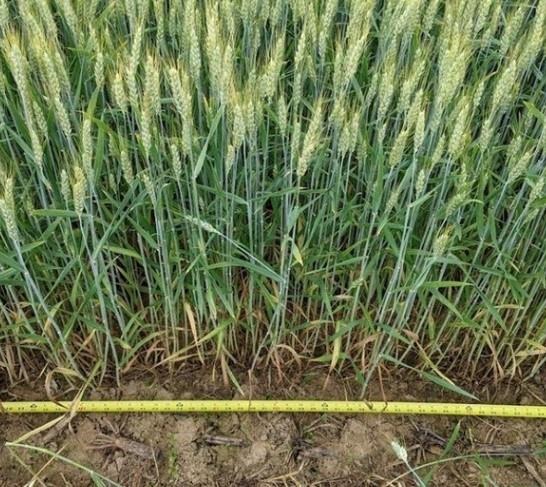By Heidi Reed
On Monday, June 6 and Tuesday, June 7, local millers, grain brokers, and agronomists toured Mid-Atlantic wheat growing regions in an effort to estimate new crop yield and quality.
Average yields presented were estimated several weeks before harvest, and randomly sampled from a few locations in large fields using the protocol outlined at " Home Stretch: Evaluating Your Small Grain Crops " (Figure 1). These estimates may not reflect actual harvest yields. Since the wheat tour took place, some isolated heavy rainfall and wind have already caused severe lodging in some fields, which will lower yields.

Figure 1. The first step to yield estimates is counting the number of viable tillers in 5 feet of row. Photo Credit: Heidi Reed, Penn State
Adams, Franklin, and York Counties:
- 8 fields
- Planting date: October 1 to October 28
- Seeding rate: 726,000-2.1 million seeds per acre
- Estimated yield: 101 bu/A (range 85-131 bu/A)
-- 2021 - 103 bu/A (range 81-140 bu/A)
-- 2020 - 110 bu/A (range 81-139 bu/A)
-- 2019 - 81 bu/A (range 60-120 bu/A)
Berks, Lancaster, and Lebanon Counties:
- 6 fields
- Planting date: October
- Seeding rate: 1.3 to 1.9 million seeds per acre
- Estimated yield: 103 bu/A, range 90 to 118 bu/a
-- 2021 - 79 bu/A (68-111 bu/A)
-- 2020 - 105 bu/A (44-119 bu/A)
-- 2019 -99 bu/A (88-106 bu/A)
All fields received fall fertility, including chicken litter, and 10 of 14 received growth regulator in the spring. Fungicide applications occurred during the vegetative stage and at flowering in all fields, with Miravis Ace favored for the late application. According to the Fusarium Head Blight Prediction Center, scab risk was low to moderate for varieties with any resistance to scab during the week or two around flowering. With these two considerations, it is not surprising that scab incidence was very low in all fields, less than 1% and often less than <0.5% incidence. However, fields were at the milk stage to transitioning to soft dough, so it was a bit early to detect scab at the time of the tour. Some diseases were present at low levels at multiple fields, including leaf rust and Stagnospora glume and leaf blotch. Powdery mildew reached moderate levels in Lebanon and Berks Counties. Cereal leaf beetle damage was present but very minor.
The high yielding field was Pioneer 25R28, seeded mid-October and at the lowest seeding rate. It received the full battery of split N, growth regulator, fall fertility, and double fungicide application.
With harvest set to start in the next 3-4 weeks in the southeast, we hope yield and quality will hold, save some lodging from expected scattered thunderstorms.
Source : psu.edu